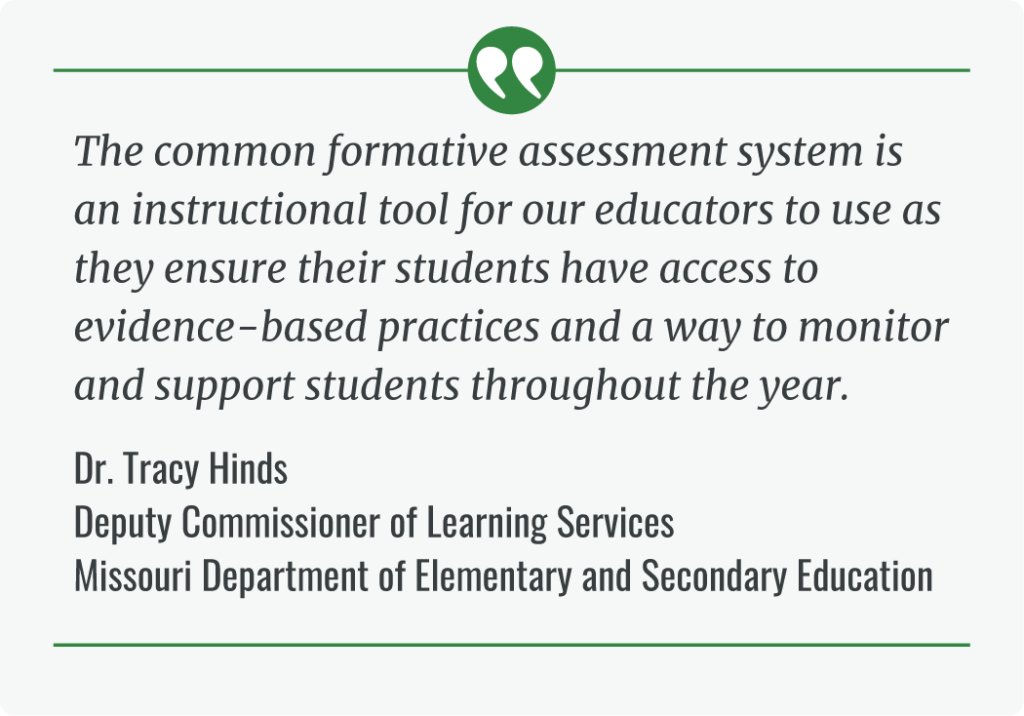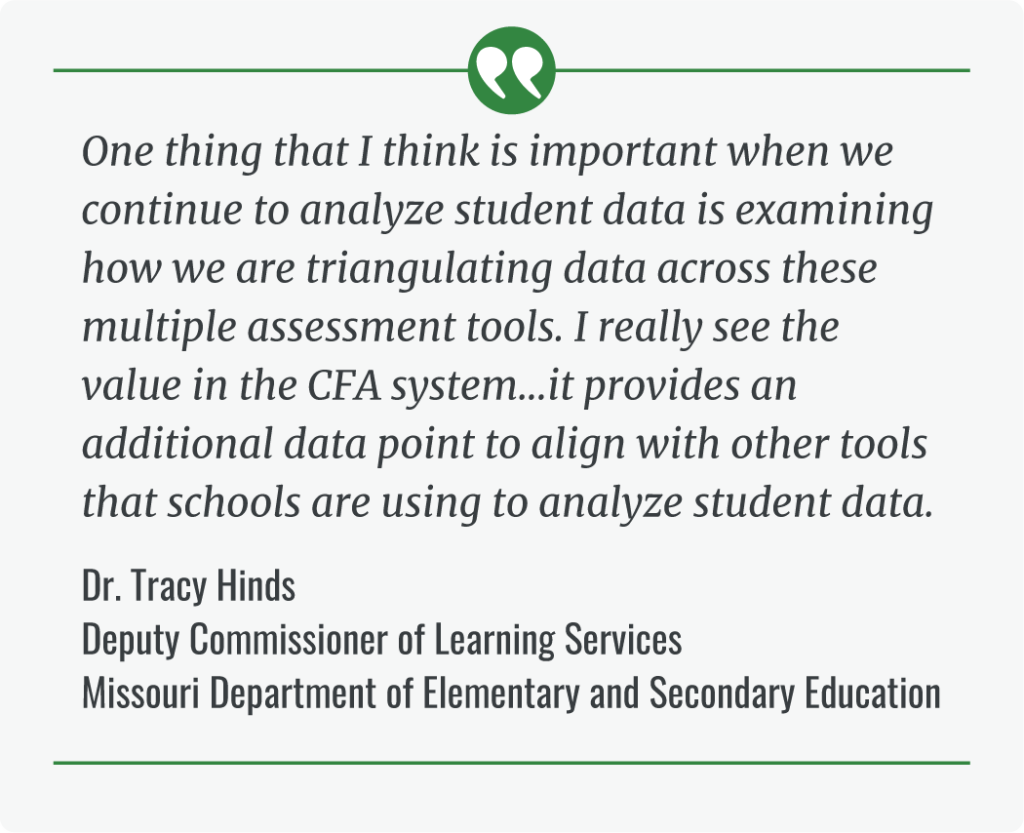Voices from the Field spotlights stakeholders in Region 12 and their work to improve educational opportunities and outcomes. R12CC is privileged to collaborate with and share the insights of Dr. Tracy Hinds, Deputy Commissioner of Learning Services at the Missouri Department of Elementary and Secondary Education.
 The Region 12 Comprehensive Center (R12CC) is working with the Missouri Department of Elementary and Secondary Education (DESE) to implement a common formative assessment (CFA) system. The CFA system will provide Missouri educators with equitable access to common formative assessments for student learning in all content areas, with initial efforts focused on early literacy in grade 2.
The Region 12 Comprehensive Center (R12CC) is working with the Missouri Department of Elementary and Secondary Education (DESE) to implement a common formative assessment (CFA) system. The CFA system will provide Missouri educators with equitable access to common formative assessments for student learning in all content areas, with initial efforts focused on early literacy in grade 2.
Can you talk about how Senate Bill 681 links to the Common Formative Assessment work?
Senate Bill 681 was passed in 2022 and there was an intentional focus on literacy as well as instructional materials. The CFA system provides a way for us to monitor where we are with literacy, to be more proactive than reactive. Pre 681 we were already working on a grade 2 statewide summative assessment. We had noticed there was a gap when kids were hitting 3rd grade, and research shows what potential outcomes result if students are not on grade level by grade 3.  With CFA, we felt it was still important to focus on grade 2 with reading proficiency. This provides an instructional tool for our educators to use as they ensure their students have access to evidence-based practices and a way to monitor and support students throughout the year.
With CFA, we felt it was still important to focus on grade 2 with reading proficiency. This provides an instructional tool for our educators to use as they ensure their students have access to evidence-based practices and a way to monitor and support students throughout the year.
What will the CFA system look like in action?
First and foremost, it will be an interactive tool for teachers to access anytime they need to have materials and resources that are aligned to our Missouri priority standards with literacy in second grade. As far as in action, it looks like teachers accessing these tools that are provided for them. It looks like state leaders providing professional development and ongoing support so that teachers understand how to access the materials and resources. It looks like teachers coming together in data teams or weekly meetings to analyze student data and identify where their students are and what are areas of growth with regards to literacy in second grade. What are the instructional strategies that we need to implement based off of the information that we are receiving? How do we need to adjust instruction based off of our students’ performance on their common formative assessments? So, it really looks like an instructional tool. I really want to underscore the importance of the instructional aspect of the common formative assessment—we want this to be a guide for teachers to inform their instruction. It is an instructional tool that gives them guidance on what they need to focus on, or what are areas that they can accelerate based off of student performance.
How has the Region 12 Comprehensive Center supported the CFA work across your offices within the Department?
The support has been phenomenal. Not only do we have our team members from DESE, but we have representation across the multiple offices. It was important for us to engage with not only the Office of Literacy, but we also have members from the Office of Special Education, the Office of College and Career Readiness, and the Office of Quality Schools, because we know this impacts and integrates work in each of these spaces.
The Region 12 Comprehensive Center was very thoughtful in identifying who needs to be part of this conversation outside of just one office because this is an agency initiative, an agency goal. It was important to have representation across the department. Further, I’m sure you can imagine that it took multiple individuals to come to a final product. We had to stretch beyond our office at DESE, and we leaned heavily on our regional professional development centers and our literacy experts—approximately 50 literacy experts from across the state supported the development and creation of our tool. It was a concerted effort that was supported and under the leadership and guidance of R12CC to ensure that we had cross collaboration with the development and implementation of this important project.
What do you hope schools and students gain from the CFA system?
There are multiple layers to this question. First, I hope it gives them an opportunity to see progress that is being made as students reach proficiency in literacy. And I feel that the collective conversations that teachers are having with their team members, with their leaders within the building, is important. It is a common language that teachers are having with one another.  And when we talk about formative assessment and the involvement of students, really taking it that step further and allowing students to be part of that process. What goals are students making based off of where they currently are? When we look at the different strands, instructional strands within literacy that a teacher may decide to focus on, it gives the students an opportunity to see where they are and what additional steps they need to take with their goal setting as they assess. I hope students and schools gain those pieces and that they see this is an instructional resource that will support them with their instruction, with their learning. And again, it is an instructional tool that is used to further develop student proficiency and educator understanding of implementing evidence-based instructional practices so that our students are performing well and accessing literacy.
And when we talk about formative assessment and the involvement of students, really taking it that step further and allowing students to be part of that process. What goals are students making based off of where they currently are? When we look at the different strands, instructional strands within literacy that a teacher may decide to focus on, it gives the students an opportunity to see where they are and what additional steps they need to take with their goal setting as they assess. I hope students and schools gain those pieces and that they see this is an instructional resource that will support them with their instruction, with their learning. And again, it is an instructional tool that is used to further develop student proficiency and educator understanding of implementing evidence-based instructional practices so that our students are performing well and accessing literacy.
Is there anything else you would like to share?
We know that there are multiple layers of assessment—we talk about summative assessment, we talk about interim assessment, and so on. One thing that I think is important when we continue to analyze student data is examining how we are triangulating data across these multiple assessment tools. I really see the value in the CFA system because, again, it is an instructional tool, and it provides an additional data point to align with other tools that schools are using to analyze student data.
